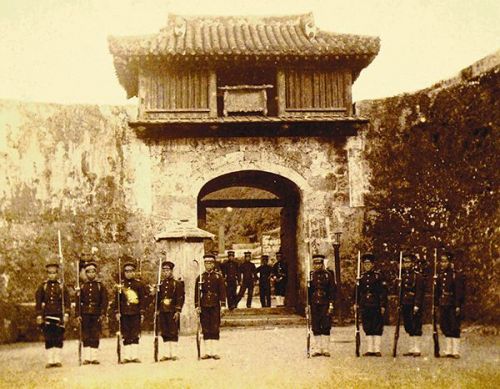“Even now colonialism continues.” Researcher calls for the restoration of self-determination for Okinawa 140 years after the Disposition of Ryukyu

Meiji soldiers lined up in front of the gate of Shuri Castle. The regiment was called the “Kumamoto Garrison” as the soldiers had been deployed from Kumamoto (Photograph from the JCII Camera Museum)
March 27, 2019 Ryukyu Shimpo
By Takahiro Miyagi
On March 27, it will have been 140 years since the Kingdom of Ryukyu was destroyed in 1879. Matsuda Michiyuki, the bureaucrat who abolished the Ryukyu Domain, entered Shuri castle accompanied by around 600 soldiers from the Kumamoto Garrison (of the Japanese Imperial Army) and armed police, and delivered to Ryukyuan King Sho Tai the official notice of the abolition of feudal domains and the establishment of prefectures. With the backing of the military power of the Japanese government Ryukyu was annexed (the Disposition of Ryukyu) with the surrender of Shuri Castle, and Okinawa Prefecture was established. Many people who talk about the right of self-determination in Okinawa and the U.S. base problems say things like “Through the new base construction at Henoko… Japanese colonialism in Japan continues since (the annexation) 140 years ago.”
Yuzo Takayama, 34, who posted an independent movie about the base problem on YouTube indicated, “Japan uses Okinawa as it pleases, their disrespect of the people there can be seen in the new base construction at Henoko.”
House of Representatives member Kantoku Teruya points to the time when he asked about the pre-annexation political status of Okinawa prior to the annexation and did not receive a clear answer from the government. “From the standpoint of international law, the manner of annexation was ridiculous. [Japanese colonialism in Okinawa] can been seen in through Japan’s use of the Administrative Appeal Act in the new base dispute.”
Shinako Oyakawa ,38, co-leader of The Association of Comprehensive Studies for Independence of the Lew Chewans (ACSILs) says, “The government definitely takes a different attitude towards Okinawa than it does for other regions. Colonialism continues 140 years later. It is important for us to take these human rights problems to the international community. In the Treaty of San Francisco, Okinawa was separated from Japan. This was called the “2nd Disposition of Okinawa.”
Chihiro Uchimura ,74, director of the Fukutsu-Kan, a museum that exhibits materials related to Okinawan politician Kamejiro Senaga, said that under U.S. rule, the people of Okinawa split into progressives and conservatives, and that, “From the infighting, [democratic] power was weakened. It broke the heart of Kamejiro, who had somehow previously unified everyone. Now, governance is even more iron-fisted than when we were under U.S. rule. We should remember the struggle of that time, and band together as Okinawans.”
(English translation by T&CT and Sam Grieb)
Previous Article:In Okinawa, Chinese and Japanese imperial era names once both used
Next Article:Restrictions on off-duty US servicemen greatly loosened, causing Okinawans concern and fear
[Similar Articles]
- Ryukyu Disposition Symposium: the 140 years since colonialism
- Restoration work of King and Queen’s room almost complete
- 260 demonstrators march through Shinjuku to protest discrimination against Okinawa in the form of U.S. bases, question Okinawa’s reversion to Japan
- Shuri Castle main hall to be restored by 2026, according to schedule decided on at ministerial meeting
- Looking back on Shuri Castle, world heritage site: 450 years of Okinawan politics and culture
 Webcam(Kokusai Street)
Webcam(Kokusai Street)


